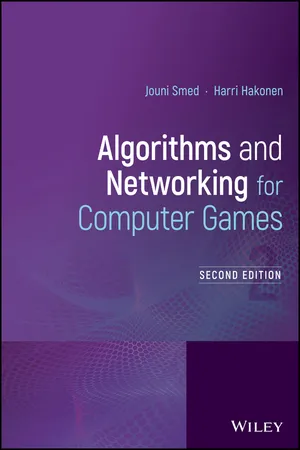
- English
- ePUB (mobile friendly)
- Available on iOS & Android
Algorithms and Networking for Computer Games
About this book
The essential guide to solving algorithmic and networking problems in commercial computer games, revised and extended
Algorithms and Networking for Computer Games, Second Edition is written from the perspective of the computer scientist. Combining algorithmic knowledge and game-related problems, it explores the most common problems encountered in game programing.
The first part of the book presents practical algorithms for solving "classical" topics, such as random numbers, procedural generation, tournaments, group formations and game trees. The authors also focus on how to find a path in, create the terrain of, and make decisions in the game world.
The second part introduces networking related problems in computer games, focusing on four key questions: how to hide the inherent communication delay, how to best exploit limited network resources, how to cope with cheating and how to measure the on-line game data.
Thoroughly revised, updated, and expanded to reflect the many constituent changes occurring in the commercial gaming industry since the original, this Second Edition, like the first, is a timely, comprehensive resource offering deeper algorithmic insight and more extensive coverage of game-specific networking problems than ordinarily encountered in game development books.
Algorithms and Networking for Computer Games, Second Edition:
- Provides algorithmic solutions in pseudo-code format, which emphasises the idea behind the solution, and can easily be written into a programming language of choice
- Features a section on the Synthetic player, covering decision-making, influence maps, finite-state machines, flocking, fuzzy sets, and probabilistic reasoning and noise generation
- Contains in-depth treatment of network communication, including dead-reckoning, local perception filters, cheating prevention and on-line metrics
- Now includes 73 ready-to-use algorithms and 247 illustrative exercises
Algorithms and Networking for Computer Games, Second Edition is a must-have resource for advanced undergraduate and graduate students taking computer game related courses, postgraduate researchers in game-related topics, and developers interested in deepening their knowledge of the theoretical underpinnings of computer games and in learning new approaches to game design and programming.
Frequently asked questions
- Essential is ideal for learners and professionals who enjoy exploring a wide range of subjects. Access the Essential Library with 800,000+ trusted titles and best-sellers across business, personal growth, and the humanities. Includes unlimited reading time and Standard Read Aloud voice.
- Complete: Perfect for advanced learners and researchers needing full, unrestricted access. Unlock 1.4M+ books across hundreds of subjects, including academic and specialized titles. The Complete Plan also includes advanced features like Premium Read Aloud and Research Assistant.
Please note we cannot support devices running on iOS 13 and Android 7 or earlier. Learn more about using the app.
Information
1
Introduction
- players who are willing to participate in the game;
- rules which define the limits of the game;
- goals which the players try to achieve during the game;
- opponents or opposing forces which prevent the player from achieving the goals;
- a representation of the game in the real world.

- Challenge. Rules define the game and, consequently, the goal of the game. When players decide to participate in the game, they agree to follow the rules. The goal motivates the players and drives the game forward, because achieving a goal in the game gives the players enjoyment.
- Conflict. The opponent (which can include unpredictable humans and random processes) obstructs the players from achieving the goal. Because the players do not have a comprehensive knowledge of the opponent, they cannot determine precisely the opponent’s effect on the game.
- Play. The rules are abstract but they correspond to real-world objects. This representation concretizes the game to the players.
[Play] is an activity which proceeds within certain limits of time and space, in a visible order, according to rules freely accepted, and outside the sphere of necessity or material utility. The play-mood is one of rapture and enthusiasm, and is sacred or festive in accordance with the occasion. A feeling of exaltation and tension accompanies the action, mirth and relaxation follow. (Huizinga 1955, p. 132)
- agon (competition) describes games where the aim is to beat the opponent and luck does not play a significant role (e.g. chess);
- alea (chance) describes games where luck or chance is the decisive factor on the outcome (e.g. Roulette);
- mimicry (role-play) describes games where the players go through an adventure with their characters in a game world (e.g. Dungeons & Dragons);
- ilinx (vertigo) describes games that affect the player’s observations or movements (e.g. Dance Dance Revolution).
To play a game is to attempt to achieve a specific state of affairs [prelusory goal], using only means permitted by rules [lusory means], where the rules prohibit use of more efficient in favour of less efficient means [constitutive rules], and where the rules are accepted just because they make possible such activity [lusory attitude]. I also offer the following simple and, so to speak, more portable version of the above: playing a game is the voluntary attempt to overcome unnecessary obstacles. (Suits 2014, p. 43)
1.1 Anatomy of Computer Games
- coordinating the game process (...
Table of contents
- Cover
- Title page
- Copyright
- Preface
- Acknowledgements
- 1 Introduction
- Part I Algorithms
- Part II Networking
- Appendices
- Bibliography
- Ludography
- Index
- EULA